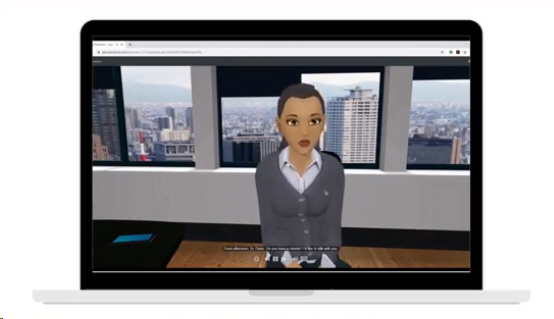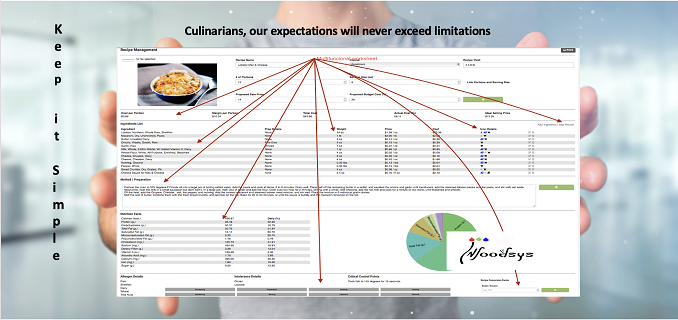Interactive microlearning tech teaches hospitality industry execs & employees how to effectively address and resolve critical and angst-inducing issues via interactive real-world scenarios—in just 15 minutes or less
 The benefits of simulation-based training are indisputable and innumerable. Given its power and efficacy, this methodology is used in a litany of sectors beyond aerospace and military, where it gained its initial foothold. These certainly includes hospitality, reports indicate. No longer reserved for mammoth corporations, now F&B businesses of every size and scope can benefit from highly optimized interactive cyber-training innovations. This in the form of short-burst microlearning 3D simulations that are now as accessible as they are effective. Such brief, easy-to-digest content, which learners can access on their own time, provides numerous posthaste benefits. At its highest level, modern 3D simulation remote training methods can immediately teach employees how to effectively navigate difficult conversations and communicate in a way that drives optimal outcomes and enriches relationships—all irrespective of where that employee is based.
The benefits of simulation-based training are indisputable and innumerable. Given its power and efficacy, this methodology is used in a litany of sectors beyond aerospace and military, where it gained its initial foothold. These certainly includes hospitality, reports indicate. No longer reserved for mammoth corporations, now F&B businesses of every size and scope can benefit from highly optimized interactive cyber-training innovations. This in the form of short-burst microlearning 3D simulations that are now as accessible as they are effective. Such brief, easy-to-digest content, which learners can access on their own time, provides numerous posthaste benefits. At its highest level, modern 3D simulation remote training methods can immediately teach employees how to effectively navigate difficult conversations and communicate in a way that drives optimal outcomes and enriches relationships—all irrespective of where that employee is based.
This kind of interactive microlearning technology, which complements any in-person training initiatives, is helping companies rapidly improve internal and external communication skills relating to sensitive subject matter and operational mandates. This includes reducing customer confusion, rectifying unconscious bias to create a more inclusive culture, stemming microaggressions, promoting conflict resolution and de-escalation, conveying appropriate and consistent responses to crises like COVID-19, driving feedback conversations that enhance employee relations, empowering employees to constructively escalate issues that aren’t discussed outside of “water cooler whispers” and more.
So powerful is this approach, Allied Market Research indicates the virtual training and simulation market size, currently valued at $204.41 billion, is projected to more than double and reach $579.44 billion by 2027. This and other such forecasts reflect the extent to which companies are now requiring their executives and managers to participate in virtual training and simulation to become better prepared for real-life situations. Not surprising given the several points of substantiation. For one, global consulting firm Accenture underscores that “experiential learning has long been argued as the most effective way to learn, and studies have shown that learning through experience increases learning quality by up to 75%.” The firm indicates this approach allows companies to recreate real-life situations, reduce travel costs to outside training and increases repetition of experiences to allow employees to practice more. As one case in point, it notes that major retailers like Walmart leverage the technology to train managers to prepare for key events like Black Friday—with potential benefits including an 80% savings in training time.
 “3D simulations help companies provide employees with interactive bite-sized learning sessions that provide a quick and easy way to engage in real-world scenarios, explore emotional responses and receive immediate feedback so they can reflect on their own performance—all in a safe virtual environment,” said Ed Beltran, CEO of Fierce Conversations—a company spearheading customized simulations that teach employees how to handle difficult customer conversations like those relating to the coronavirus pandemic, diversity and inclusion and other notorious, angst-inducing points of contention.
“3D simulations help companies provide employees with interactive bite-sized learning sessions that provide a quick and easy way to engage in real-world scenarios, explore emotional responses and receive immediate feedback so they can reflect on their own performance—all in a safe virtual environment,” said Ed Beltran, CEO of Fierce Conversations—a company spearheading customized simulations that teach employees how to handle difficult customer conversations like those relating to the coronavirus pandemic, diversity and inclusion and other notorious, angst-inducing points of contention.
“This kind of training can address and resolve veritably any on-the-job challenge,” he says. “The overarching goal of microlearning immersion is to help employees become expert conversationalists by knowing what to talk about, how to talk about it and why it matters for the bottom line of the specific employer. This is why the most effective 3D simulations are those that are ‘bite-sized’—as in 15-minutes or less—and also fully customized for each business and situation. In this way, businesses can efficiently address several critical issues via interactive real-world situations, all with the look and feel of your own location, organization and audiences. Personalized avatars are also used to recreate scenarios and build empathy, and immediate feedback helps employees learn and improve with each session.”
Learn and improve they do, as gamification capabilities are shown to maximize learner engagement and knowledge retention. In fact, interactive learning is not only shown to boost learning engagement by 50%, but it also enhances knowledge retention by more than 20%. “It also scales cost effectively per learner so employers can mitigate training expenses,” Beltran notes. Duration is also key. According to Software Advice, most employees (58%) would more likely use online learning courses if they were broken into “multiple, shorter lessons” and creates more than 50% higher engagement. Additional metrics indicate microlearning in segments of three to seven minutes “matches the memory capacity and attention spans” of most humans.
So, next time you need to address internal complications or generally enhance operations, consider opting for interactive 3D simulations rather than those long, boring training videos. You know, the ones that cause employees to lose interest and are hard-pressed to truly resolve the issues at hand—especially when you need that genuine resolution fast. Such customized 3D real-world microlearning, practiced virtually, can get to the heart of challenges that employees are facing today with immediacy. The result will be conversations that make a real, meaningful and measurable impact.
Read Also: Unexpected Reasons Your Crisis Management Plan Might Fail
Forbes Business Council Member Merilee Kern, MBA is an internationally-regarded brand analyst, strategist and futurist who reports on noteworthy industry change makers, movers, shakers and innovators across all B2B and B2C categories. This includes field experts and thought leaders, brands, products, services, destinations and events. Merilee is Founder, Executive Editor and Producer of “The Luxe List” as well as Host of the nationally-syndicated “Savvy Living” TV show. As a prolific business and consumer trends, lifestyle and leisure industry voice of authority and tastemaker, she keeps her finger on the pulse of the marketplace in search of new and innovative must-haves and exemplary experiences at all price points, from the affordable to the extreme — also delving into the minds behind the brands. Her work reaches multi-millions worldwide via broadcast TV (her own shows and copious others on which she appears) as well as a myriad of print and online publications. Connect with her at www.TheLuxeList.com and www.SavvyLiving.tv / Instagram www.Instagram.com/LuxeListReports / Twitter www.Twitter.com/LuxeListReports / Facebook www.Facebook.com/LuxeListReports / LinkedIN www.LinkedIn.com/in/MerileeKern.
Sources:
- https://enyotalearning.com/blog/industries-where-simulation-and-gamification-are-a-perfect-match/
- https://www.alliedmarketresearch.com/virtual-training-and-simulation-market
- https://www.accenture.com/_acnmedia/pdf-86/accenture-extended-reality-immersive-training.pdf
- https://www.softwareadvice.com/resources/top-lms-features-employee-engagement/
- https://www.researchgate.net/publication/318657319_Microlearning_an_Evolving_Elearning_Trend
- https://www.softwareadvice.com/resources/top-lms-features-employee-engagement/
- https://blog.originlearning.com/microlearning-a-top-2020-learning-trend/
All images courtesy of www.FierceInc.com







